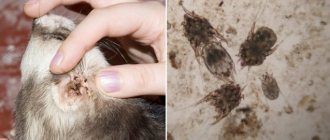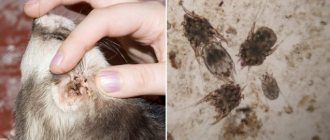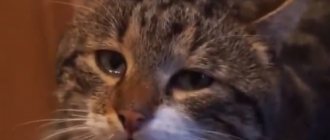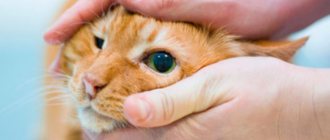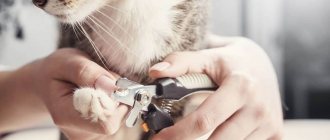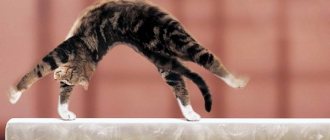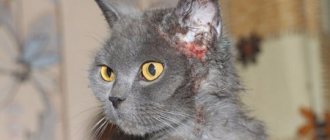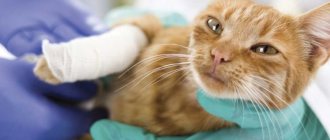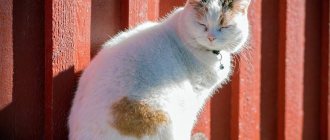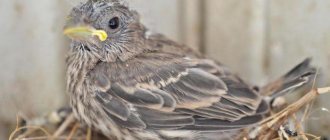Not every cat copes with stressful situations equally easily. For example, when an animal needs to be taken to the veterinarian, or to the country, or even to an exhibition. As a result of the move, the cat may become frightened and stressed, after which it will not be itself for several days. Obviously, to help the animal in this case, sedatives for cats are needed during transportation . Therefore, let’s look at what they are, what is worth using, and what is very undesirable.
[adsense]
Calming for cats at home
There are two products that can be present in the house and act as a sedative on cats. However, the real result of their influence differs from that which can be seen in the behavior of the animal after their application. Let's find out why this is so.
Valerian for cats is not a sedative, but a drug!
If valerian acts as a sedative on a person, then for a cat it is a real drug. The fact is that the active substance of medicinal valerian (medical name for valerian) is similar to the pheromones of a cat during estrus. Because of this, it acts more like Viagra on cats, and even more so on cats, rather than as a sedative. In addition, already from the first time the cat begins to become addicted and dependent on valerian. The conclusion is simple - cats should never be given valerian!
Catnip is a weak version of valerian
You will often hear that catnip is a good sedative for cats. But in reality this is not the case, because it acts on the animal in exactly the same way as valerian, only several times weaker. That is, in essence, catnip does not act as a sedative on the cat, but only changes its behavior. In addition, if some animals love mint and rub quite near it, then it may not affect others (even in the form of a scattering of dried mint and in the form of a spray).
Side effects
Uncontrolled use of sedatives causes addiction and a number of side effects. These include:
- redness of the skin, itching and hair loss;
- nausea and vomiting;
- bloating and diarrhea;
- tachycardia and hypotension;
- runny nose and increased tearfulness;
- drowsiness.
Despite the fact that sedatives for cats have a calming effect on the body, in some cases the effect of their use may be the opposite. If treatment with sedatives only worsens anxiety and irritability, then it should be discontinued.
Sedatives for cats
And so, we will not use “folk remedies” for cats as a sedative. Another thing is medical supplies. So, sedative tablets or drops will help when transporting a cat, during the cat’s heat, and during aggression. Therefore, let's look at popular, and most importantly, effective sedatives for cats.
Calming drops and tablets for cats
- "Fitex" for cats is available in the form of drops. If you are looking for a sedative for cats on the go , this product is perfect. It contains motherwort, valerian, hops and skullcap - this combination helps to normalize heart function and relieve the animal’s feeling of fear, so transporting the cat will become easier.
- “Stop-stress” for cats is available in the form of drops and tablets. This sedative for cats and cats normalizes the action of the animal’s brain (reducing activity in excitation cells). The product is quite strong, but does not cause addiction.
- “Cat Bayun” is a sedative for cats in the form of tablets and solution. First of all, it is intended to combat the aggressiveness of the animal (if the cat is constantly marking its territory, it is too nervous). This remedy also eases estrus in cats.
[ads-2]
Hormonal sedatives for cats and cats
- “Sex Barrier” for cats is a hormonal drug, therefore it is not recommended to be used without the recommendation of a veterinarian. This sedative is given to cats to ease their natural instincts.
- *To get rid of an animal’s natural sexual attraction, you can have your cat spayed or neutered.
Chemical sedatives
To calm raging kittens, in addition to homeopathic medicines, medications of chemical origin are also used:
- VetSpokoin and Stop-stress contain medicinal herbs and sedative components.
- Amitriptyline helps cope with your pet's anxiety and territory marking.
- Buspirone is an excellent remedy for phobias.
- Clomipramine is prescribed for a stressful situation and phobia that has arisen in a kitten.
- Diazepam is a good remedy for epilepsy and anxiety.
- Xylazine drops have a quick calming effect. They should be used when immediate calm is needed.
- Medetomidine is used by a veterinarian for simple procedures in a clinical setting.
- Vetranquil is used to relieve stress in kittens due to upcoming travel.
These drugs should only be used when prescribed by a veterinarian, since violation of the dosage of sedatives can lead to the death of the animal.
Calming medications for animals can only relieve the cause of the kitten's stress; they will not help cope with the cause of the cat's stress.
Sleeping pills for cats (tranquilizers)
If sedatives for cats do not help your pet during transportation, and you need to transport it from one point to another, you can do this while the animal is sleeping. Although it is recommended to give a sleeping pill (tranquilizer) only on the recommendation of a veterinarian, and even better - to have the doctor inject it himself, in especially severe cases you can take a risk. Of course, if you stick to the dosage and know how to give injections, there is practically no risk.
Sleeping pills for cats for transportation
Below is a list of real sleeping pills for cats that will help transport the animal during sleep. Recommended dosages and route of administration may sometimes change (if the components of the drug change), so always check the package insert for the tranquilizer.
- "Vetranquil" - 0.15 ml subcutaneously;
- "Butorphanol" - 0.3 ml intramuscularly;
- "Relanium" - 0.3 ml intramuscularly;
- "Nalbuphine" - 0.2 ml intramuscularly.
Remember, the sleeping pills listed above for cats should never be given at the same time. Also, do not forget to provide the animal with a comfortable position with an elongated neck, as well as access to air and a warm blanket after falling asleep.
[ads-4]
Rules for taking medication
Do not give animals drugs that have expired or exceed the dosage. Since many products cause severe dehydration, it is necessary to ensure constant access to water. If convulsions, excessive drooling, respiratory depression, foam at the mouth, or vomiting occur, contact your veterinarian immediately.
Before moving, the pet is given medication 2-3 days in advance. Feeding is stopped 12 hours before transportation. Before a long journey, food portions are reduced, but the amount of water is not limited (boiled water is given). If the owner has experience, he can do the injections himself, but it is still recommended to consult a veterinarian.
First, the cat is immobilized by wrapping it in a towel so that it cannot pull its paws out. Then the skin on the withers is pulled back a little, a needle is quickly inserted, and the medicine is injected. If drugs are given in the form of powder or drops, then they are added to food. The tablets are pre-crushed and then mixed with food.
For cats that have been given sleeping pills, you need to create conditions for restful sleep:
- choose a loose, comfortable bed;
- the muzzle is laid on its side;
- cover with a blanket;
- provide access to fresh air (so that the cat does not vomit during sleep).
The dosage of sleeping pills must be precisely calculated. This depends on the pet’s resistance to stress, the presence of current diseases, age, and duration of transportation. Therefore, only a veterinarian should prescribe the dose of sleeping pills. It is prohibited to give cats sedatives intended for humans.
Before using medications, you need to find out the cause of agitation and aggression. Perhaps you should be more attentive to the cat, pay more attention, stroke it, play. When an animal feels love, it will be calm and affectionate. But sometimes you can’t do without sedatives.
Sedative for cats - drug reviews
about Fitex calming drops for cats , writes Ekaterina. “Our cat is not sterilized, we have kittens once a year and that’s great, but between breaks, when she’s in heat, it regularly spoils our sleep. We decided to save ourselves with sedatives for cats. The nearest veterinary pharmacy only had Kot Bayun, so we bought it. However, we didn’t notice any results from it, so we started looking further. We found Fitex - 5 drops slightly diluted in water and after 20 minutes the cat calms down. It suited our cat!”
Interesting things about cats:
- Bengal cat photo and character of the breed, price of kittens, list of nurseries;
- Diarrhea in a cat - how and how to treat it at home;
- Toyger cat - photo, price of kittens and where to buy, description of the breed.
Review of Kot Bayun, a sedative for cats , writes Nastya. "Hi all! I have a British cat, she is two years old and has already given birth to kittens twice. When we give kittens away, she always gets nervous and worried, so she decided to try some kind of sedative. The choice fell on Kot Bayun, at first she gave it only after she gave away the kittens, and then she tried it again when the heat began. The tablets helped, I’m glad that they are also inexpensive.”
Where to buy and how much it costs
The purchase of any medications should be made in specialized places - pharmacies. It is also possible to purchase some drugs in pet stores. Since all well-known, trusted trading companies have online platforms where the best manufacturers exhibit their products, you can order goods online in an online store. If these are not prescription drugs, experienced consultants at pet stores will be able to tell you what they are and advise which one is best to buy. The funds are usually budgetary.
Tips for using sedatives
Sedatives for cats are only a method of eliminating the consequences, not the cause. So they are not a panacea for cases such as aggression towards new animals in the house, or fear of the unknown (your guests). In such cases, you should try to re-educate your pet. And finally, a few tips:
- Do not under any circumstances overuse sedatives for cats, because in some cases this can lead not only to the animal becoming addicted to the drug, but also cause health problems;
- If, after being sedated, the animal begins to vomit, become excessively drowsy, or have another undesirable effect, the cat’s body has reacted atypically to one of the components of the drug, so it is better to consult a veterinarian before choosing the next drug.
When to use medications
Sedatives are prescribed when there are clear signs of disruption of the nervous system and anxious behavior. Mental disorders can manifest themselves in different ways, but this will be immediately noticeable by the animal’s unusual behavior.
Sedatives and sleeping pills are used in the following cases:
- for nervous disorders accompanied by increased nervousness, obsessive actions - overeating, hyperactivity, frequent, prolonged licking;
- during an air flight, a boat trip;
- when a new person or dog appears at home (this can provoke depression, fear, aggression);
- before surgery or examination, wound treatment, vaccination;
- if there is aggression towards guests or strangers;
- new place of residence (a sudden change in the usual environment causes severe stress in the cat);
- for mental disorders (phobias, aggression, fear, severe anxiety);
- the need to adapt to a new environment (for example, overexposure);
- before exhibitions (the cat begins to get nervous due to large crowds of people and animals);
- before salon procedures (grooming, combing, cutting);
- when moving for a long time, the cat begins to panic; it may be frightened by unfamiliar smells, sounds, even vibration;
- to prevent territory marking - while the cat is excited due to hormonal surges, strong sexual desire - all this can be reduced with the help of sedatives.
Animals should not be punished when trying to take a dominant position. Sedative herbal remedies will help relieve aggression and tension. Mental deviations manifest themselves as hunting for a ghostly target, twitching of the head, paws, sudden jumps, bouncing. Or a pet’s aggression directed at itself, constant licking, which leads to hair loss, the formation of erosions, and wounds.
How are sleep disorders diagnosed in children?
To facilitate correct diagnosis, parents should be encouraged to record their children's sleep and wake patterns using sleep diaries over a 24-hour period for at least two continuous weeks before the first visit. This may be useful in confirming sleep-related complaints as well as in taking a thorough history. Sleep diaries also help identify day-to-day variations in sleep patterns that can often be missed by routine history taking. Graphic diaries are more useful for understanding children's sleep-wake cycles.
Parents can also complete the 26-item Sleep Disorders Questionnaire for Children (SDSC), which was developed for children and adolescents to screen for primary sleep disorders such as obstructive sleep apnea.
Medical evaluation of a child with sleep disorders includes calculation of body mass index (BMI) and waist circumference measurements are important because higher BMI and larger waist circumference are independent risk factors in predicting the severity of sleep disordered breathing, especially in older obese children. Equally important is measuring blood pressure. The physical examination may be focused (eg, examining the upper respiratory tract and nasal passages in a healthy, typically developmental child with parental complaints of snoring and excessive daytime sleepiness) or comprehensive (eg, in children with neuromuscular disorders and chronic illnesses). In addition to the physical examination, radiological studies such as a lateral X-ray of the neck (if adenoidal hypertrophy leading to obstructive sleep apnea is suspected) and laboratory studies such as serum iron and ferritin levels (if limb movements associated with sleep apnea are suspected) may be helpful. sleep).
Overnight polysomnography is recommended as the gold standard for diagnosing sleep-related breathing disorders, such as obstructive sleep apnea, in children and adolescents. However, polysomnography is not useful for diagnosing behavioral sleep disorders such as behavioral insomnia. Diagnostic tests such as the multiple sleep latency test (MSLT) can be useful for quantifying sleepiness and examining the presence of sleep disorders (eg, narcolepsy) that may predispose children and adolescents to daytime sleepiness.
Specific sleep disorders in children and adolescents
Sleep disorders related to breathing
Breathing-related sleep disorders include habitual snoring, obstructive sleep apnea, upper airway resistance syndrome, and obstructive hypoventilation syndrome. In children and adolescents, concerns about symptoms (eg, snoring) that indicate an underlying breathing disorder, such as obstructive sleep apnea, require exploration of associated symptoms such as pauses in breathing, chronic morning headaches, dry mouth, nighttime bedwetting, morning thirst, feeling sluggish and tired upon waking, a history of chronic ear infections, recent weight gain, hyperextension of the neck during sleep, and chronic mouth breathing.
The main cause of breathing-related sleep disorders in children is adenotonsillar hypertrophy. If there are no signs of tonsil enlargement, other common causes include macroglossia (enlarged tongue), retrognathia (backward displacement of the jaw), high arched palate, and deviated nasal septum. Nasal polyps or posterior nasopharyngeal obstruction may also play a role. It is also important to note that children with disorders such as Down syndrome or Prader-Willi syndrome have craniofacial abnormalities, including midfacial hypoplasia or micrognathia, which predispose them to breathing problems leading to sleep disorders. Other risk factors include obesity, chronic sinus problems, and allergies.
Sleep disorders associated with movement disorders.
Sleep-related movement disorders in childhood include sleep myoclonus in infancy, rhythmic movement disorder, periodic limb movement disorder, and restless legs syndrome. Sleep myoclonus in infancy is usually associated with clusters of myoclonic jerks that affect the entire body, trunk, or extremities. They are generally considered benign and gradually disappear after six months of age without requiring further treatment.
With a rhythmic movement disorder, the child demonstrates repetitive and stereotypical motor behavior involving large muscle groups and mainly during sleep. This disorder can also lead to daytime mobility problems and physical injuries. The diagnosis can be definitively made after videopolysomnography. Treatment includes providing a safe sleeping environment for the child and reassuring parents that the disorder will resolve on its own by age 5.
Periodic limb movements during sleep are short twitches (movements) of the lower or upper limbs during sleep that can last up to five seconds periodically at intervals of 20-40 seconds.
Restless legs syndrome manifests itself as an urge to move the legs that begins or worsens while sitting or lying down, but resolves completely with movement. The urge to move is stronger in the evening or at night than during the day, or occurs only in the evening or at night. Typically, children under 2 years of age present with senestopathies, such as “spider crawling” or “tickling feet.”
Actually childhood insomnia
Insomnia in children is defined as repeated difficulties in the initiation, duration, maintenance or quality of sleep that occurs despite age-appropriate time and opportunity to sleep, resulting in daytime functional impairment for the child and/or family. Behavioral insomnia in childhood most often manifests as sleep refusal or resistance at bedtime, delayed sleep onset, and/or prolonged nighttime wakefulness requiring parental intervention. When sleep onset is disrupted, children have difficulty falling asleep on their own and associate falling asleep with certain circumstances, such as a certain place (sofa or bed of parents), the presence of a person (mother or grandmother) or certain actions (bottle feeding, rocking, watching TV). Thus, these circumstances are necessary for the child to fall asleep or continue to sleep after waking up in the middle of the night.
In another variant of insomnia, the child delays bedtime through multiple requests or refusals, while the parent has difficulty setting limits for the child that allow bedtime to be delayed. Sometimes both types of insomnia can occur at the same time.
Sleep disorders in children associated with mental disorders
Sleep problems can be caused by childhood mental disorders. For example, increased arousal in attention deficit hypermobility disorder (ADHD) is associated with delayed sleep onset and reduced sleep duration in children and adolescents. In addition, deficits in sensory integration, disruption of circadian rhythms, rebound effects of psychostimulants, and comorbid anxiety disorders contribute to insomnia in children with ADHD.
Subjective sleep complaints are common in children with major depressive disorder as well as anxiety disorders. There is a bidirectional relationship between sleep disturbances in children and affective states. In other words, a child's unstable emotional state can lead to persistent sleep problems, and chronic sleep deprivation can lead to behavioral and mood disorders.
Sleep disturbances in children with PTSD may include a variety of parasomnias, including nightmares, sleep enuresis, and severe insomnia. There are two types of post-traumatic stress disorder in children with distinct sleep disturbances: trauma, in which children experience a specific acute traumatic event leading to hyperarousal and associated insomnia, and trauma, in which children experience chronic traumatic stressors. Nightmares, a specific sleep disorder, are extremely common in children and adolescents suffering from traumatic events, such as sexual abuse or physical abuse, and are usually not treatable. The thematic content of nightmares in PTSD is related to previously experienced trauma.
Parasomnias
Parasomnia is defined as unwanted physical events or experiences that occur while falling asleep, while asleep, or during awakenings from sleep. They are classified as rapid eye movement (REM) parasomnias or non-REM parasomnias. Parasomnias without REM sleep (also called arousal disorders) are associated with simple or complex behavior as a consequence of arousal in the first half of the night. They are associated with confusion and amnesia for nightmares or events in the night. Agitation, nightmares, and sleepwalking (somnambulism) are considered part of a non-REM sleep parasomnia. Confusion usually occurs immediately after falling asleep or in the early morning and is associated with short-term confusion in the thought process after waking up. There appears to be an increased prevalence of these disorders in early childhood, which usually resolves by age 5 years.
Nightmares are associated with inconsolable crying (consolation usually only delays recovery from the incident) and increased activity of the autonomic system. Night terrors seem to go well in childhood. However, more severe forms of the disease may require behavioral interventions such as scheduled awakenings and treatment with benzodiazepines (eg, clonazepam).
Sleepwalking is usually associated with chronic sleep deprivation. Therefore, it is important to maintain adequate sleep hygiene to prevent such episodes. It is also important to note that certain conditions (such as Tourette's syndrome and migraines) are also associated with an increased prevalence of somnambulism.
Still have questions?
Get an online consultation from leading pediatricians in St. Petersburg!
A professional and experienced pediatrician will answer your questions.
Medical care for a child without leaving home at a convenient time.
sign up for a consultation
A Skype consultation lasts 45 minutes.
